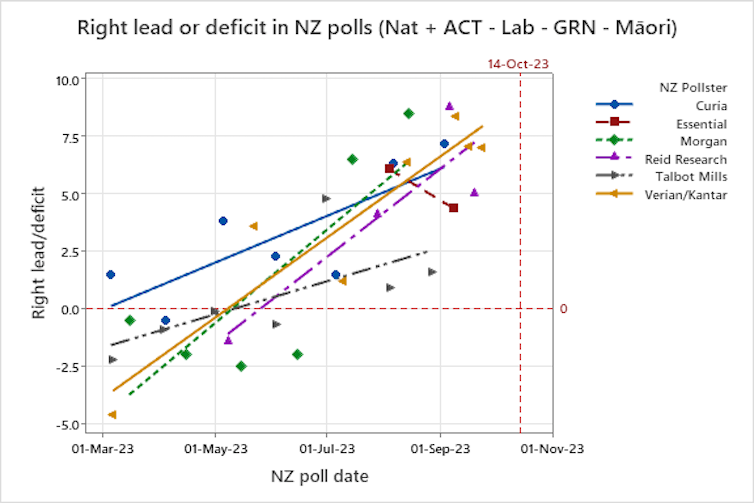Yesterday’s 1News-Verian poll, and the Newshub-Reid Research poll reported earlier in the week, both show flattening trend lines – but they are still moving to the right of the political spectrum.
For the purposes of this analysis, the National and ACT parties are counted as the right coalition; Labour, the Greens and Te Pāti Māori/the Māori party are the left coalition. I am not counting NZ First towards either coalition, as they have supported both left and right in the past.
Since my previous analysis two weeks ago, there have been three more polls released. The two weekly 1News-Verian polls have given the right coalition two 7.1-point leads, after an 8.4-point lead in mid-September.
The most recent Verian poll was taken between September 23 and 26 from a sample of 1,002 people. The Reid Research poll was taken just before that, between September 17 and 23. More dramatically, it saw the right dip to a 5-point lead, down from 8.8 points in the previous poll in early September.
NZ First on the rise
The graph below shows the right coalition’s lead or deficit against the left coalition in all polls conducted since March. While the left regained some ground in the latest polls, the trend to the right remains evident.
Significantly, NZ First has moved over the 5% threshold required to enter parliament without winning a single-member seat, with the latest Verian poll giving the party 6% and Reid Research 5.2%.
The Māori Party is expected to win single-member Māori-roll seats, giving it parliamentary representation with a vote share well under 5%.
If NZ First makes the 5% threshold, it may be in the “kingmaker” role. Reid Research gives all parties’ support to one decimal place, so the 5.2% for NZ First is greater than the right’s 5-point lead over the left in that poll.
Verian only gives decimal figures for parties below 5%. The right’s lead of 7.1 points implies it could do without NZ First’s 6%.
However, the pollster’s seat totals use the decimals. Using the decimal figures to project seats in parliament, the right would win 60 of the 120 seats, the left 52, and New Zealand First eight. In this case, the right would be one seat short of a majority.
NZ’s Green Party is ‘filling the void on the left’ as voters grow frustrated with Labour’s centrist shift
Shift to the right
Although New Zealand First supported the left from 2017 to 2020, it is unlikely to do so again. So it’s only a question of whether National and ACT can govern alone, or will need NZ First as well.
If there has been movement against the right recently, a plausible reason is voter anxiety over ACT having a larger voice in government. In the past, ACT has been a minnow party, with National dominating the conservative vote.
This election, however, has seen more voters signalling support for parties other than Labour or National. At the 2020 election, ACT won 7.6% of the party vote, up from just 0.5% in 2017, and is now mostly polling in the double digits. So is the Green Party, well up from 7.9% at the previous election.
Labour, meanwhile, has crashed from 50% in 2020 to the high 20s in recent polls, with National up from 25.6% to the high 30s. If National and ACT are able to form a two-party coalition government, ACT could drive New Zealand to the right.
What role NZ First and its leader Winston Peters might play remains (not for the first time) the great imponderable as the October 14 election draws near.




